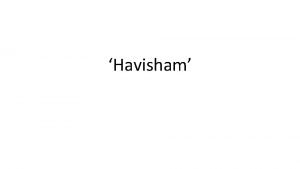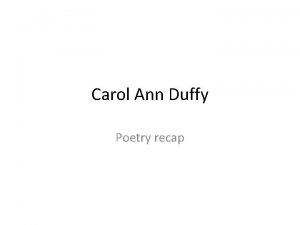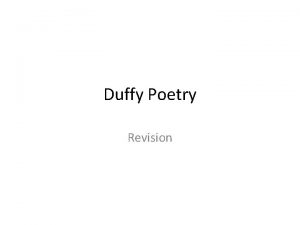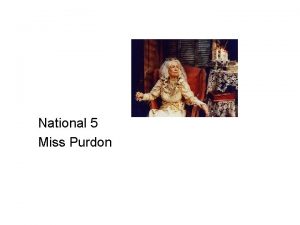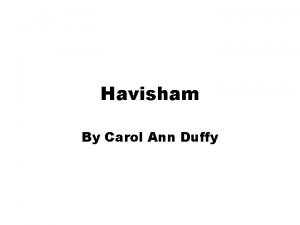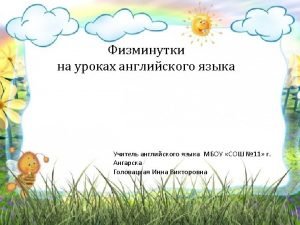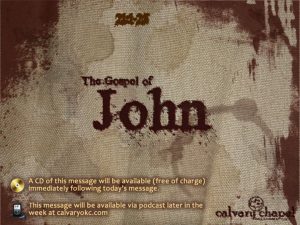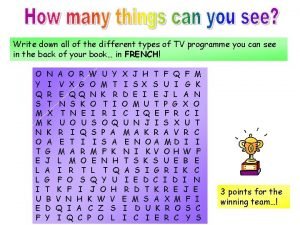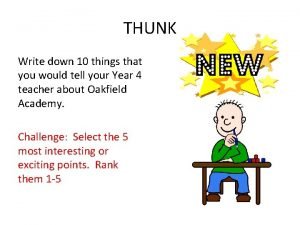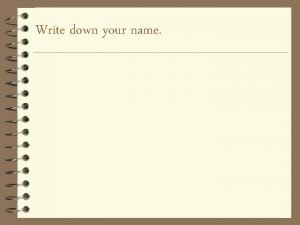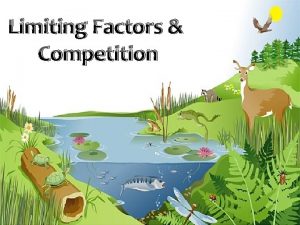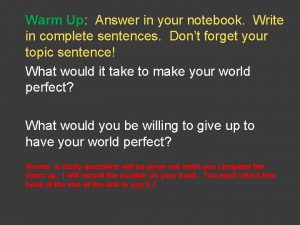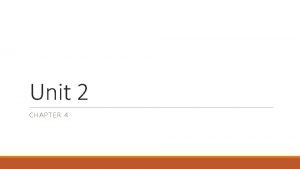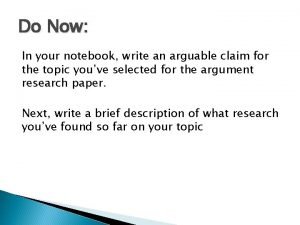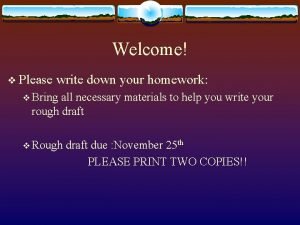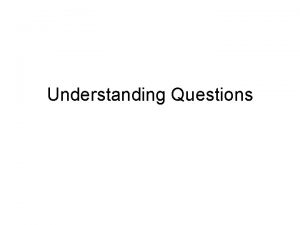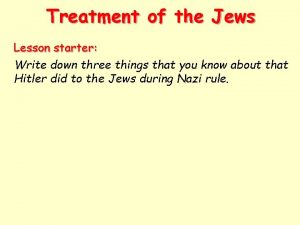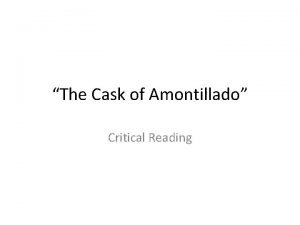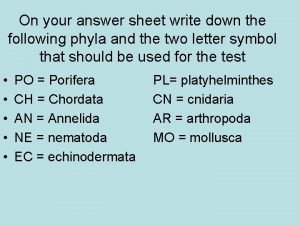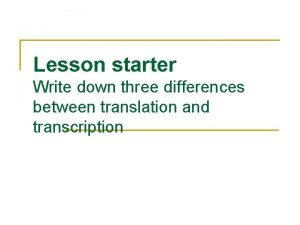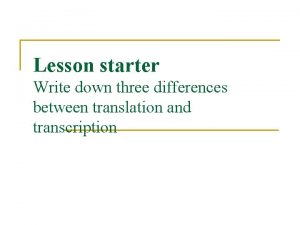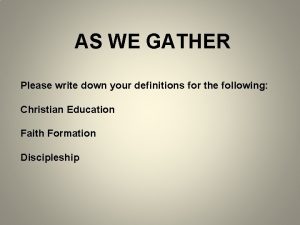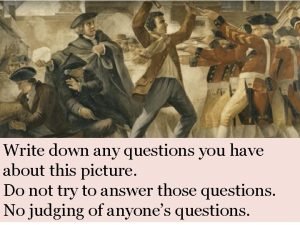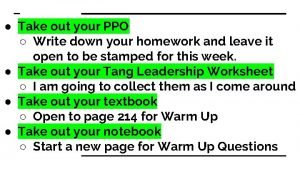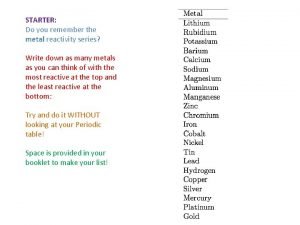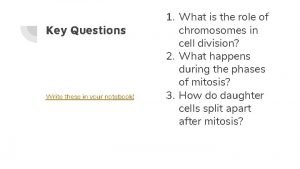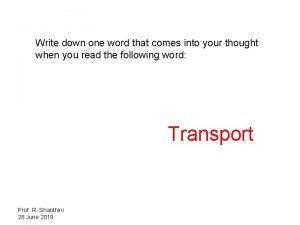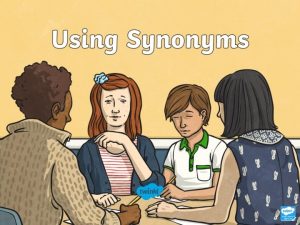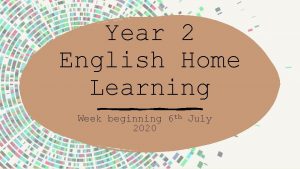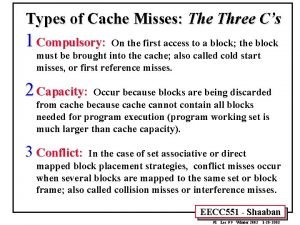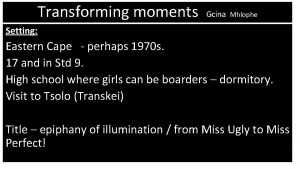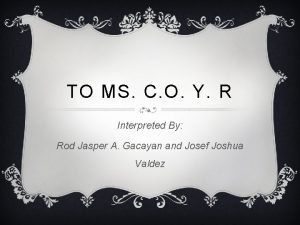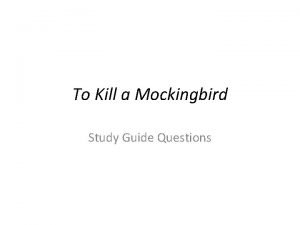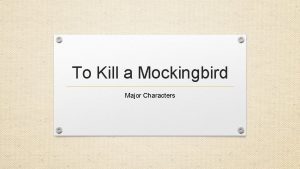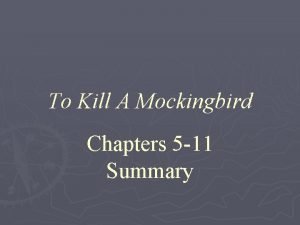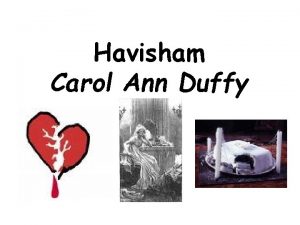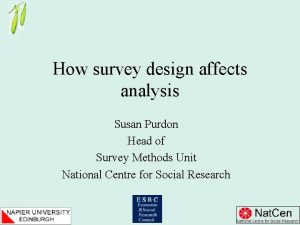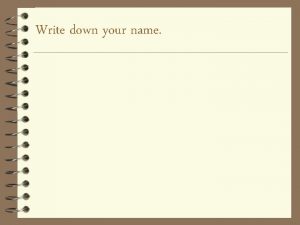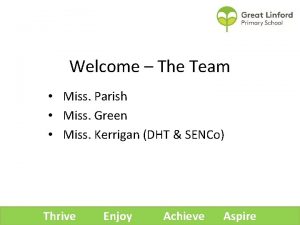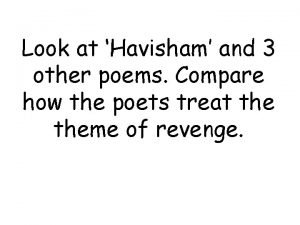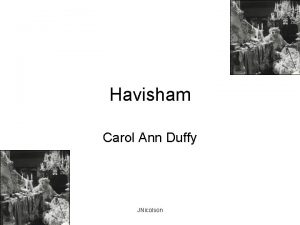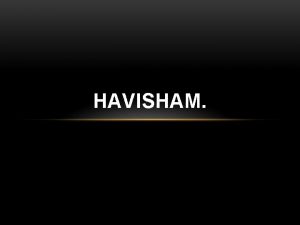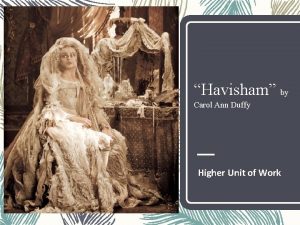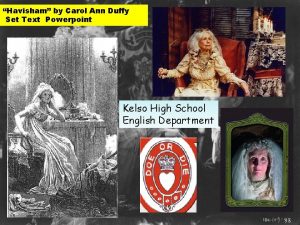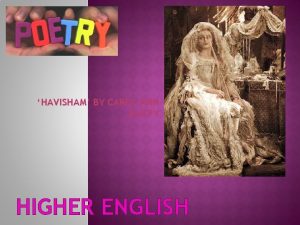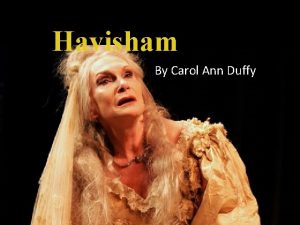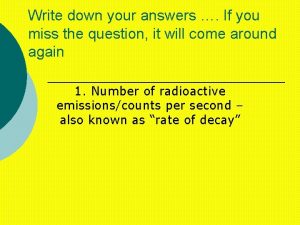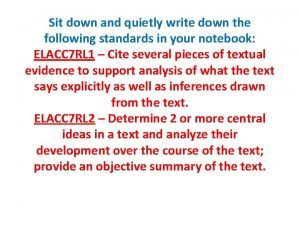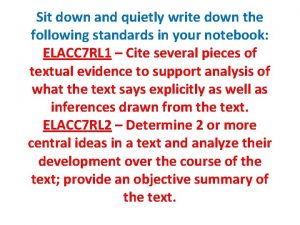Havisham National 5 Miss Purdon Write down at


















































- Slides: 50

Havisham National 5 Miss Purdon

Write down at least 3 things that you find interesting/weird. Think about why those things might be happening and be ready to report on your answers.

Learning Objectives We are learning about the character of Miss Havisham from Great Expectations to gain a deeper understanding of the influence behind Duffy’s poem, Havisham.

Who is Miss Havisham? Miss Havisham is a character from Charles Dickens ‘Great Expectations’. This poem is an outpouring of her bitterness, anger and resentment. Miss Havisham’s status as a spinster is significant as it is a label she detests. The word spinster was most commonly used in Victorian England to describe an unmarried woman over a certain age. The word has a certain social stigma attached; particularly in Victorian England unmarried women were viewed as ‘improper’.

Individually Read the Extract

Extract: Individual work Individually, underline anything that tells you about Miss Havisham and her situation. Remember to use the text as evidence to back up your opinion. What has happened to Miss Havisham? How do you know? What kind of character does she seem? Why? What is her mental state? How is this shown in the text? Identify two examples of word choice and explain how it could tell us a bit more about Miss Havisham’s character.

Great Expectations extract She was dressed in rich materials - satins, and lace, and silks - all of white. Her shoes were white. And she had a long white veil dependent from her hair, and she had bridal flowers in her hair, but her hair was white. Some bright jewels sparkled on her neck and on her hands, and some other jewels lay sparkling on the table. Dresses, less splendid than the dress she wore, and half-packed trunks, were scattered about.

Great Expectations extract She had not quite finished dressing, for she had but one shoe on - the other was on the table near her hand - her veil was but half arranged, her watch and chain were not put on, and some lace for her bosom lay with those trinkets, and with her handkerchief, and gloves, and some flowers, and a prayer-book, all confusedly heaped about the looking-glass.

Great Expectations extract It was not in the first few moments that I saw all these things, though I saw more of them in the first moments than might be supposed. But, I saw that everything within my view which ought to be white, had been white long ago, and had lost its lustre, and was faded and yellow. I saw that the bride within the bridal dress had withered like the dress, and like the flowers, and had no brightness left but the brightness of her sunken eyes.

Great Expectations extract I saw that the dress had been put upon the rounded figure of a young woman, and that the figure upon which it now hung loose, had shrunk to skin and bone. Once, I had been taken to see some ghastly waxwork at the Fair, representing I know not what impossible personage lying in state. Once, I had been taken to one of our old marsh churches to see a skeleton in the ashes of a rich dress, that had been dug out of a vault under the church pavement. Now, waxwork and skeleton seemed to have dark eyes that moved and looked at me. I should have cried out, if I could.

Havisham: the poem Background This poem, written by Carol Ann Duffy in 1998, is a dramatic monologue spoken by the character Miss Havisham from Charles Dickens’ ‘Great Expectations’. Jilted by her scheming fiancé hours before her wedding, Miss Havisham continues to relive the pain which she felt following her heartbreak. We witness her sitting amid the remains of her wedding day, decaying alongside her surroundings and plotting revenge on all men. Purpose Why dramatic monologue? The poem is written in dramatic monologue in order to obtain the character’s innermost thoughts and feelings. As a result of this, the reader is given an insight into the conflict between love and hate, and the way in which one event can change a person’s life. Is this similar to anything else we have studied? Important note: Miss Havisham’s account must be reflected upon as a biased view of events, as the reader is given only one side of the story.

Let’s Read the Poem…

Havisham – Let’s read: Initial responses In your pairs, and using your copy of the poem, pick out at least 4 things that tells you something about the character of Havisham. Remember WISTS: Word choice, Imagery, Sentence Structure, Tone and Sound techniques.

Discussion Questions in pairs. One person writes, the other person reports to the class. You decide… Why does the poet omit Miss Havisham's title and refer to her by her surname only? Why does the poet write “spinster” on its own? What does Miss Havisham think about this word and its relevance to her? What technique is “Nooooo” and “b-b-breaks”? Why are these words written in this way and what effect do they have? What is the meaning of the image of “a red balloon bursting”? How far does the poet want us to sympathize with Miss Havisham? Give examples of when the poem does/does not cause sympathy. Does the reader have to know about Great Expectations to understand the poem? Why? Does Miss Havisham have a fair view of men? What do you think of her view of being an unmarried woman? Perhaps the most important part of the poem is the question “who did this/to me? ” How muchdoes the poem show that Miss Havisham is responsible for her own misery?

Success Criteria We have learned about the character of Miss Havisham from Great Expectations and have gained a deeper understanding of the influence behind Duffy’s poem, Havisham.

Havisham Miss Purdon

Discussion Questions in pairs. One person writes, the other person reports to the class. You decide… Why does the poet omit Miss Havisham's title and refer to her by her surname only? Why does the poet write “spinster” on its own? What does Miss Havisham think about this word and its relevance to her? What technique is “Nooooo” and “b-b-breaks”? Why are these words written in this way and what effect do they have? What is the meaning of the image of “a red balloon bursting”? How far does the poet want us to sympathize with Miss Havisham? Give examples of when the poem does/does not cause sympathy. Does the reader have to know about Great Expectations to understand the poem? Why? Does Miss Havisham have a fair view of men? What do you think of her view of being an unmarried woman? Perhaps the most important part of the poem is the question “who did this/to me? ” How much does the poem show that Miss Havisham is responsible for her own misery?

‘Havisham’ by Carol Ann Duffy Form: The poem is a dramatic monologue in which Duffy adopts a persona (Miss Havisham). The poet is not speaking as herself but rather putting herself in the position of the character in order to give us an insight into her possible thoughts and feelings. Meaning: The poem deals with the consequences of bitterness and an inability to let go of the past. Other themes include: loss, violence, love/hate.

The dramatic monologue gives a powerful insight into the potential thoughts and feelings of the character from Dickens’ famous novel. Miss Havisham was jilted at the altar and never recovered from it. As a result, she allows herself to be consumed with bitterness. The mental torture of the character is encapsulated in the first line of the poem which highlights that she is torn between loving and hating the man who has caused her so much anguish. Moreover, this psychological damage is evident in her decaying appearance; her outward appearance is a manifestation of her inner decay.

IMAGERY Metaphor “I’ve dark green pebbles for eyes. ” This metaphor compares Miss Havisham’s eyes to pebbles. JUST AS pebbles are hard, cold and shiny and green is associated with jealousy SO TOO are Havisham’s eyes. This suggests Havisham has become bitter and cruel, emotionless and possibly vengeful.

“ropes on the back of my hand. ” The veins/sinews on Miss Havisham’s hands are being compared to ropes. -prominent veins emphasise that she is old but has not really lived. -ropes can be used for strangulation. -this suggests that Miss Havisham’s bitterness has made her violent and vengeful; she fantasises about killing the man who jilted her. Perhaps she is also tied to the past.

‘Havisham’recap The speaker in the poem is the character of Miss Havisham, taken from the Dickens novel ‘Great Expectations’. In the novel, she is deserted at the altar on her wedding day by her husband-to-be. She is completely devastated and never recovers. She continues to wear her decaying wedding dress, adopts a daughter and brings her up teaching her to hate all men. The poem is a dramatic monologue.

Verse 1 What does the oxymoron in line one reveal about her feelings? Explain the image ‘dark green pebbles for eyes. ’ Remember “Just as… so” Explain the image ‘ropes on the back of my hands. ’

Verse 1 Beloved sweetheart bastard The poem begins as if addressed to the jilting bridegroom. It doesn't continue in this direct address - by the end of the poem the male figure will have become a male corpse - any male (generalised). The most striking thing about the first sentence is the combination of 'love' (beloved sweetheart) and hatred (bastard). Duffy is interested in the unstable combination of desire and hatred.

Verse 1 Oxymoron – emphasises her contradictory feelings Heavy emphasis here perhaps indicating her negative/aggressive feelings are now the dominant ones. Beloved sweetheart bastard. Not a day since then I haven’t wished him dead. Prayed for it so hard I’ve dark green pebbles for eyes, ropes on the back of my hands I could strangle with. Accentuated veins - due to age, stress, murderous anger etc. Hardened emotions? Dark for her evil thoughts of revenge. Green link with jealousy? Lack of transparency – might highlight the way she conceals her true feelings. Irony – we usually pray for something good. Highlights the intensity of her vengeful desires.

STRUCTURE Use of enjambment -emphasises the spoken, rambling nature of the poem. -also, lack of clear structure highlights Miss Havisham’s insanity and lack of coherence. Write down an example of enjambment and explain its effect…

LANGUAGE Violent word choice emphasises Miss Havisham’s rage: ‘bang’, ‘strangle’ etc. ‘Spinster’. Minor sentence. Physically isolated in the poem, emphasising Miss Havisham’s physical and emotional isolation from the rest of the world. ‘cawing noooo!’ -cawing is associated with crows-it is a harsh, almost painful sound. ‘Noooo’ is onomatopoeic and emphasises the depth of her emotion. The overall effect is a visceral, almost animal wailing.

‘yellowing’ wedding dress -shows that she is physically and mentally weak. -still wearing dress -refusal to let go of the past. -outward decay mirrors the deterioration of her soul. Wedding cake -symbol of her dashed hopes and dreams. -by stabbing the cake she is symbolically stabbing the man. This is a disturbing, violent image which is an expression of her murderous desire for revenge.

Verse 2 Comment on the sentence structure of the first line. What is her attitude to the fact she is unmarried? Comment on the use of the word ‘stink’. Comment on the use of the word ‘cawing’. Comment on the last line – can you explain the structure?

Verse 2 Placed at start of stanza and minor sentence adds emphasis. Mirrors Havisham’s isolation. Negative connotations creating a bitter tone. Animalistic Emphasises primitive rawness of emotions. Spinster. I stink and remember. Whole days Doesn’t recognise in bed cawing Nooooo at the wall; the dress herself – profoundly changed by rejection. yellowing, trembling if I open the wardrobe; the slewed mirror, full-length, her, myself, who did this Ambiguous – her or the dress? Perhaps she is frightened of looking in the mirror and seeing what she has become. Onomatopoeia emphasises Emphasises intensity of her anguish isolation. She’s closed in Avian terminology used to show she feels demeaned or rejected by her lover who has flown the nest?

Verse 3 What connotations are there for ‘puce’ (dark red)? What is the speaker describing in lines 10 -13? What might this reveal?

Verse 3 Enjambment – to convey the idea of run away emotions and a lack of control? To evoke a troubled, restless mind? Also changes the emphasis of blame. Deep red – connotations of puce? Dried blood? Disease? to me? Puce curses that are sounds not words. Some nights better, the lost body over me, my fluent tongue in its mouth in its ear then down till I suddenly bite awake. Love’s When she wakes the hatred anger return Sexual fantasy/dream reveals she cannot rid herself of her desire/affection which now torments her in the living nightmare of her waking existence.

Verse 4 What could the ‘red balloon’ symbolise and what is the significance of it bursting? Comment on the use of onomatopoeia. What is the tone of this verse? Comment on the use of repetition in the final line.

Verse Alliteration. Might symbolise her 4 broken heart, her life destroyed abruptly? Shows how fragile love can be. hate behind a white veil; a red balloon bursting in my face. Bang. I stabbed at a wedding-cake. Give me a male corpse for a long slow honeymoon. Don’t think it’s only the heart that b-b-b-breaks. Command. A morbid, macabre, erotic perverse request. Deeply disturbed, vengeful and malevolent. Long + slow – combination of enjoyment and torture Repetition highlights her emotional and psychological fragility. As well as her heart, her mind is now broken. Minor sentence /onomatopoeia emphasises power/sudden ness of above.

TONE The tone of the poem is bitter, angry and vengeful. This is emphasised by the poet’s use of language and imagery. There is also a feeling of regret-her sexual fantasies show us that she laments the loss of a relationship/lover she never had and never will have. Write down two quotations that convey tone and explain your evidence.

Thoughts Perhaps Miss defines the character socially - whereas the poem concentrates on the nature of the character's individual feelings - the character's psychological/sexual nature, rather than her social being. The lack of ‘miss’ makes her seem less of a woman. However, Duffy wants to examine the sexuality of Miss Havisham and explore the sheer amount of pain the character has suffered. This is why Duffy chooses to write the poem in the first person.

Themes The poet is effectively exploring a number of themes in this poem. What might they be?

Themes Damage that can be done by insensitive males/partners. Relationships – the thin line between love and hate. How one event can profoundly affect a life. How some people never recover from personal trauma. How social convention/prejudice can cause unhappiness.


Essay Skills Introduction: T. A. R. T. S (tm) Title of text Author of text Reference to Task Summary Theme of text Message ‘Havisham’ is a poem where strong feelings are conveyed. Compare this poem to another Duffy poem you have studied which also conveys strong feelings.

Example TARTS ‘Havisham’ by Carol Ann Duffy is a poem in which strong feelings are conveyed. The poem is a dramatic monologue of a character who has been jilted on her wedding day and ruins her own life by failing to move on. Another poem by Carol Ann Duffy in which strong feelings are conveyed is ‘Valentine’. The poem is also a dramatic monologue where the speaker offers their lover an unusual valentine’s gift. The poem explores the positive and negative sides of love.

P. C. Q. E POINT: Make a point, referring to the words in the essay question. Don’t use the words ‘I’ or ‘you’! Use characters’ names, not ‘he’ or ‘she’

P. C. Q. E CONTEXT: Introduce your quotation, briefly Say what page, scene, or line the quotation is on Explain who is speaking, and what is happening in this scene or part of the text.

P. C. Q. E QUOTATION: ALWAYS USE QUOTATION MARKS! Don’t change the words in the text. Remember to make this quotation relevant to your point.

P. C. Q. E EXPLANATION: EXPLAIN how your quotation proves the point you made (P) It should refer back to the question. Pick out words or phrases from your quotation to ANALYSE (think about connotations of the word choice etc) Try to give an opinion (but do not say “I think” – Instead say “This suggests” or “This shows”

P. C. Q. E Example Havisham has strong vengeful feelings about her lover who jilted her on her wedding day. This is shown from the beginning of the poem, in stanza 1, when she tells the reader that there hasn’t been a day where she hasn’t “wished him dead”. Havisham also tells the reader that she has “prayed for it”. This suggests that Havisham has strong feelings about her lost love as not a day goes by where she doesn’t think about carrying out her revenge. The word “pray” is unusual in this context because normally you would pray for someone to live, not die. This suggests Havisham’s vengeful feelings are strong because praying requires high levels of time and dedication.

Mini Essay: Havisham is a poem where strong feelings are conveyed. Compare this poem to another Duffy poem you have studied which also conveys strong feelings. Plan: Introduction = TARTS 3 points of Havisham that show strong feelings. (P. C. Q. E) 2 points of Valentine that shows strong feelings Conclusion

Themes: Can you find relevant quotations that could supportthe theme? Revenge – Throughout the poem it becomes clear that the character blames the breakdown of her life on her ex fiancé and this particular event. The character spends her days and the entirety of the poem plotting his demise and death. Self-loathing- While the subject matter of the dramatic monologue is her ex-fiancé, it is clear that Miss Havisham is angry at, or may actually blame herself. The character speaks of herself in such a derogatory and offhand manner. Love vs. Hate- There is a continuous conflict between the love which the character felt for her ex-fiancé and the hate which she now feels for him and herself. This also shows a split in her personality and mental state as she constantly battles with these two emotions. This theme is evident throughout the poem with the conflicting word choice. Time and Decay – Throughout this poem this theme is evident through the way both the character and her physical surroundings are rotting and decaying. The character begins to lose her identity as the materials around her lose their appearance. It can be argued that the character is also losing her mind and her sense of self. Time has not healed her mental wounds; instead it has only fed her anger and hatred.

STRUCTURE Use of enjambment -emphasises the spoken, rambling nature of the poem. -also, lack of clear structure highlights Miss Havisham’s insanity and lack of coherence. Write down an example of enjambment and explain its effect…

LANGUAGE Violent word choice emphasises Miss Havisham’s rage: ‘bang’, ‘strangle’ etc. ‘Spinster’. Minor sentence. Physically isolated in the poem, emphasising Miss Havisham’s physical and emotional isolation from the rest of the world. ‘cawing noooo!’ -cawing is associated with crows-it is a harsh, almost painful sound. ‘Noooo’ is onomatopoeic and emphasises the depth of her emotion. The overall effect is a visceral, almost animal wailing.
 De jager v olifants tin b syndicate
De jager v olifants tin b syndicate Characteristics of dramatic monologue
Characteristics of dramatic monologue Puce curses
Puce curses Mrs havisham poem
Mrs havisham poem Havisham poem analysis
Havisham poem analysis Havisham essay
Havisham essay Carol ann duffy havisham
Carol ann duffy havisham Our father all of heaven roars your name lyrics
Our father all of heaven roars your name lyrics Hand on hip
Hand on hip There's a place where streams of grace
There's a place where streams of grace Book
Book I fled him
I fled him Write down the types
Write down the types Write down 10
Write down 10 Write down six words from juliet's speech
Write down six words from juliet's speech How do churches help the community
How do churches help the community What is hamlet's father's name
What is hamlet's father's name Write these down
Write these down Assertive conflict resolution
Assertive conflict resolution In your notebook write two sentences for each set of words
In your notebook write two sentences for each set of words In your notebook write questions about the next school year
In your notebook write questions about the next school year In your notebook write words or phrases that describe
In your notebook write words or phrases that describe Write down your homework
Write down your homework Write down the expression
Write down the expression Write down the lesson
Write down the lesson Name three of the many clever things montresor
Name three of the many clever things montresor Write down the lesson
Write down the lesson Copy and answer the following on your answer sheet
Copy and answer the following on your answer sheet Write down the lesson
Write down the lesson Write down the lesson
Write down the lesson Please write down your name
Please write down your name Write down your answer here
Write down your answer here Write down questions
Write down questions How to write down coordinates
How to write down coordinates Write down your homework
Write down your homework Take out your homework
Take out your homework Mnemonic to remember reactivity series
Mnemonic to remember reactivity series Answer the questions. write in your notebook
Answer the questions. write in your notebook Write down one
Write down one Jot down synonym
Jot down synonym National unification and the national state
National unification and the national state Write a brief note on national archives of india
Write a brief note on national archives of india Karakteristik write through didalam write policy
Karakteristik write through didalam write policy What is bossy verbs
What is bossy verbs Miss yiu
Miss yiu Types of misses
Types of misses Transforming moments grade 12 short story
Transforming moments grade 12 short story A la senorita c.o. y r.
A la senorita c.o. y r. To kill a mockingbird study guide questions
To kill a mockingbird study guide questions Tkam character profiles
Tkam character profiles Chapter 5 and 6 to kill a mockingbird
Chapter 5 and 6 to kill a mockingbird

